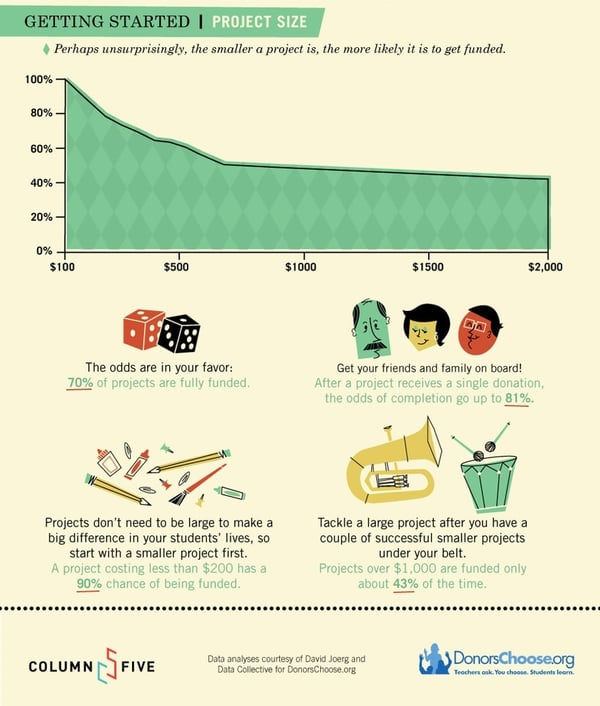It’s no secret that access to school technology can make or break a teacher’s experience with ST Math. Imagine if you could just ask for the technology your students need to succeed and then, a few weeks later, it appears. It’s not such a stretch. More than 196,677 projects for classroom technology have been funded through DonorsChoose.org, including for ST Math classrooms.
Kelly Honda, a first grade teacher at Celerity Woodmere Charter School in Harvey, Louisiana, currently has 10 iPads in her classroom thanks to DonorsChoose.org.
It starts with teachers submitting a request for whatever they need for their classroom, from petri dishes to bus rides. The project is posted online for anyone to click and donate a small amount. Over a few weeks or months, about 75% of the projects get funded. But it’s not always crowdfunding. Lately more and more major corporations are turning to DonorsChoose.org to make a direct and immediate impact on teachers and students.
Honda had her recent request for two iPads fully funded by Chevron’s Fuel Your School program within a month of being posted. “I was so excited and honored to find out that Chevron had chosen to fund my project for two iPads!” said Honda. “I had heard about the program, but never once thought that my project would be chosen.”
We asked two ST Math teachers who have successfully completed multiple DonorsChoose.org requests for classroom technology to share their insights.
Tips for ST Math Teachers Asking for Classroom Technology Grants:
- Dream big. “Don’t be afraid to put your projects on there – your big projects that really provide technology in your classroom,” said Sae Kang, a teacher at Seattle’s John Muir Elementary. “You never know who’s going to fund it.” Her recent projects for laptops in her classroom have received a boost from J Crew and Gates Foundation. Just last month, CA Technologies made news funding all open DonorsChoose.org STEM teacher requests in Nevada.
- Break it up. According to DonorsChoose.org, smaller projects are more likely to get funded. But small projects can add up to big impact. Take a cue from Honda whose class got those 10 iPads through three separate funding requests on DonorsChoose.org. “People like to contribute to a project that they can ‘see’ the end for,” Honda explained. (Check out her current request for two more Chromebooks here.)
- Be specific about impact. Especially with expensive items like technology, donors want to know how their money will have a direct impact on students, said Honda. “I asked for iPads in particular because ST Math has an app that students can use, and since I teach first graders, the touch screen is often a lot easier for them to maneuver than a computer mouse.” And the payoff? “It’s definitely helping my students make more [ST Math] syllabus progress,” she said. “We have a school-wide competition to see who can get to 100% first, and my class has consistently been in the lead.”
- Consider the calendar. Donors know that back-to-school time is crucial to teachers, and may offer matching gifts or even regional flash-funding of all projects in a given area, around August or September, says Kang. With this in mind, “You can be strategic about when you put your projects up,” she adds. The end of the calendar year may be another good time, when some donors are looking to make a positive impact and get a tax write-off before the year ends.
- Tell your friends. “Advertise it as much as you can--but not enough to annoy your friends!” recommends Honda. Use social media to let your friends and family know about your project and chip in. Tag @MIND_Research in your tweets and we may even share your request with JiJi’s friends.
- Think from a donor’s perspective. You’ll need more than your friends and extended social network to donate to your projects if you’re going to make a big impact with classroom technology. Your project description needs to attract strangers and if possible corporate investors who are looking to invest in grants for school technology. “Donors are looking for STEM, problem solving, differentiation,” says Kang. “Preparing them for 21st century and really critical skills – thinking, problem solving, collaboration -- laptops are a great way for my kids to collaborate together.” Mention those key words, as they apply to your projects, and donors are more likely to find – and fund – your project. And on that note...
- Mention STEMworks. In the past, donors such as 3M have targeted DonorsChoose.org projects that support STEM education – especially those designated as STEMworks projects. STEMworks is an honor roll of the nation’s most effective STEM education efforts, as evaluated by Change the Equation, a DC-based STEM education nonprofit. Because ST Math is an official STEMworks program, if you mention STEMworks (all one word) for a project related to ST Math, such as laptops or tablets for your ST Math rotations, you may have a leg up in your funding request.
Interested in learning more? Check out these requests for classroom technology posted by other ST Math teachers on DonorsChoose.org: Technology in the Classroom. And if you want to start your own project, visit: http://www.donorschoose.org/teachers

Comment